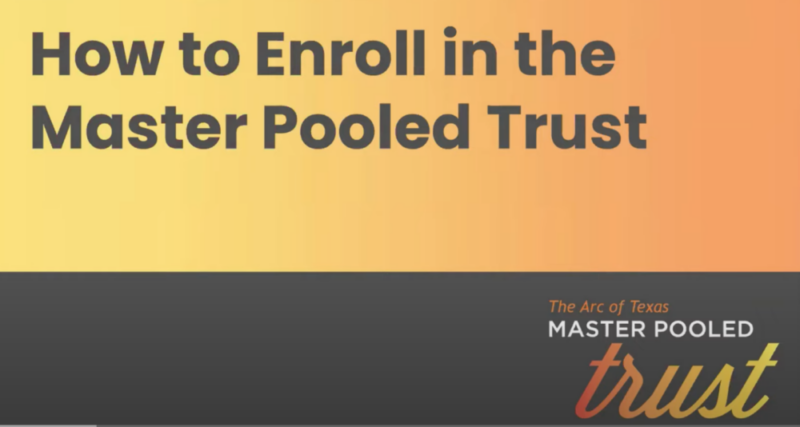Enroll in the
Master Pooled Trust
How to Enroll
Step 1: Watch explainer videos (10 minutes)

Watch the video above, or download the presentation slides (no audio).
Pulse aquí para ver el video Que es el Fideicomiso Mancomunado Principal?, o pulse aquí para descargar la presentación (láminas sin audio).

Watch the video above, or download the presentation slides (no audio).
Pulse aquí para ver el video Como Inscribirse en el Fideicomiso Mancomunado Principal?, o pulse aquí para descargar la presentación (láminas sin audio).
Step 2: Choose your trust type
We recommend you seek the independent advice of an experienced estate planning attorney or certified financial planner when selecting the type of trust that is right for your family member. (You can find an attorney under “Related Resources” at the bottom of this page.)
Discretionary trusts offer more flexibility than Supplemental trusts. If it is appropriate for the beneficiary’s situation, both basic support and supplemental payments may be paid for out of the sub-account. Discretionary trust potentially allow for shelter to be paid.
Supplemental trusts allow disbursements to be made only for supplemental needs, which include most items that are not housing costs. No matter the circumstances, shelter will not be paid for out of the sub-account.
Supplemental trusts allow disbursements to be made only for supplemental needs, which include most items that are not housing costs. No matter the circumstances, shelter will not be paid for out of the sub-account.
Note: See Enrollment Guide for Trusts I and III for information specific to those types.
Step 3: Complete the joinder agreement
| Trust Type | Trust Agreement (for your records) | Joinder Agreement (complete and mail) |
|---|---|---|
| Trust IV (Recommended) | Trust Agreement IV | Joinder Agreement IV |
| Trust III (Recommended) | Trust Agreement III | Joinder Agreement III |
| Trust II | Trust Agreement II | Joinder Agreement II |
| Trust I | Trust Agreement I | Joinder Agreement I |
Mail your completed and notarized Joinder Agreement, along with the $600 enrollment fee (payable to “The Arc of Texas”), to:
The Arc of Texas
Attn: Master Pooled Trust
8001 Centre Park Drive, Suite 100
Austin, TX 78754
Note: When you are ready to add funds to your account, please make a check payable to “The Arc of Texas MPT FBO [beneficiary’s name]” and mail it to the address above.
Step 4: Learn how to use your trust

Watch the video above, or download the presentation slides (no audio).
Pulse aquí para ver el video Como Usar el Fideicomiso Mancomunado Principal, o pulse aquí para descargar la presentación (láminas sin audio).
Master Pooled Trust Toolkit: Everything You Need to Know
Download the Master Pooled Trust Toolkit to reference when you have questions. It includes everything you need to know to make the most of your trust! You will receive a printed copy in the mail, as well.
Note: The trust beneficiary’s primary representative requests disbursements and receives all information about account activity. See the “Roles & Responsibilities” section of the Master Pooled Trust Toolkit for details.
Related Resources
We recommend you seek the independent advice of an experienced estate planning attorney or certified financial planner when selecting the type of trust that is right for your family member. Look for the “CLEA” certification behind an attorney’s name to ensure they are certified in elder law and understand disability benefits, estate planning, wills, and special needs trusts.
Find an attorney through Texas Chapter of the National Academy of Elder Law Attorneys, Inc. (NAELA) or through Texas Legal Services Center (TLSC). TLSC provides names of attorneys who offer services at a reduced rate and can be reached at 1-800-622-2520.
Planning ahead helps people with intellectual or developmental disabilities live well. It’s important to have a plan at every stage of life, and especially important later in life when someone’s parent or caregiver will no longer be able to provide support. Make a plan.
The following fees may be charged by The Arc of Texas Master Pooled Trust. Download the fee schedule.
-
Enrollment Fee: A non-refundable, one-time enrollment fee of $600* is due at the time the Joinder Agreement is executed to cover the cost of opening a trust sub-account for the beneficiary.
-
Annual Maintenance and Consultation Fees: There is no annual renewal fee before the sub-account is funded. After the sub-account is funded, the following annual fees are due: click here to download the fee schedule.
-
Special Assessments: The Trustee and the Manager have authority, as necessary, to assess all or certain sub-accounts with special assessments for specific costs such as the cost of defending a sub-account of the Trust, or taking actions to preserve a beneficiary’s Government Assistance. See Section 7.9 of the Trust Agreement for a description of possible defense costs.
Fee schedule for “Distributions Authorized” accounts (means disbursements will be requested)
- Annual Consultation Fee:
-
1.75% on the first $50,000
-
1.25% for amounts between $50,000 up to $100,000
-
1% for amounts over $100,000
-
Minimum annual fee: $300
-
Fee Schedule for “Distributions Deferred” accounts (means NO disbursements will be requested)
- Annual Maintenance Fee:
-
Annual Maintenance Fee:
-
1.25% for amounts up to $100,000
-
1% for amounts over $100,000
-
Minimum annual fee: $250
-
Annual Accounting Fees for Sub-accounts Requiring Annual Accountings to the Court
-
$150 for accounts with 24 disbursements or less in a year
-
$300 for accounts with more than 24 disbursements in a year
-
Up to $500 for accounts with additional complexities, including supplementary requirements by the court or items outside of the trust that must be accounted for
Other Fees
-
Frequent Disbursement Fee for disbursements that exceed 24 per year: $12.50 per disbursement.
-
IRS tax preparation fee: To be negotiated at the lowest reasonable rate
-
Closing Fee: A $100 fee will be assessed upon closure of the sub-account
-